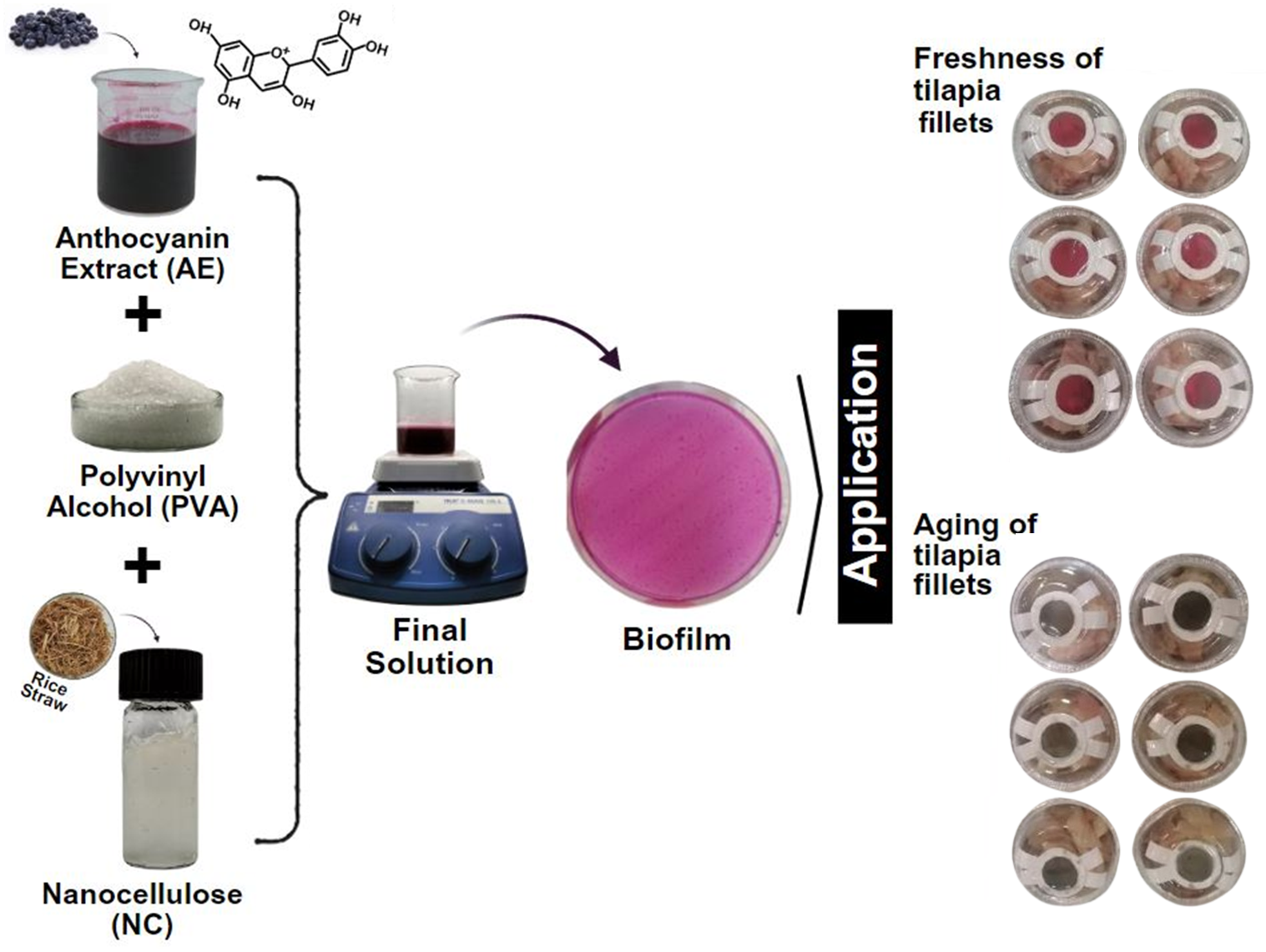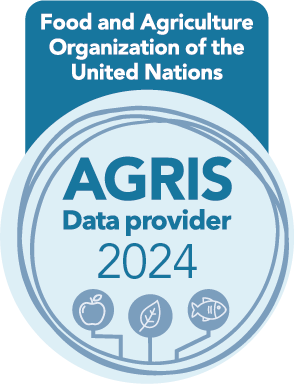Intelligent biofilm with blueberry extract, rice straw nanocellulose and polyvinyl alcohol: Characterization and its application in visual freshness monitoring in tilapia fillets
DOI:
https://doi.org/10.17268/sci.agropecu.2025.016Palabras clave:
Vaccinium corymbosum, nanotechnology, thermal degradation, mechanical properties, pH indicator, sustainabilityResumen
Intelligent packaging represents a sustainable solution for food preservation by enabling the monitoring of freshness through chromatic changes. In this study, a biofilm based on polyvinyl alcohol (PVA), nanocellulose (NC) extracted from rice straw and blueberry extract was developed and evaluated for its performance as a visual freshness indicator in tilapia fillets. Nanocellulose, obtained by TEMPO oxidation, exhibited proper integration into the polymeric matrix according to transmission electron microscopy, Fourier transform infrared spectroscopy, thermogravimetric analysis and X-ray diffraction analysis. The biofilms improved their mechanical properties with the addition of NC, by increasing tensile strength and reducing water solubility. However, the incorporation of anthocyanins increased solubility and water vapor permeability due to their hydrophilic character. Despite this, their high chromatic sensitivity to pH allowed for color changes: red in acidic media (pH 2-4) and green/brown in alkaline media (pH > 9). These visual changes validate the potential of anthocyanins as freshness indicators, positioning biofilms as a functional and sustainable alternative to conventional packaging. In addition to enabling real-time monitoring, these biofilms can contribute to reducing food waste and fostering more sustainable solutions in the packaging industry, with significant potential for innovative commercial applications.
Citas
Alcántara, J. C., González, I., Pareta, M. M., & Vilaseca, F. (2020). Biocomposites from Rice Straw Nanofibers: Morphology, Thermal and Mechanical Properties. Materials, 13(9), Article 9. https://doi.org/10.3390/ma13092138
ASTM. (1995). Standard Test Method for Tensile Properties of Thin Plastic Sheeting.
ASTM, A. (2000). Standard E96–00. Standard test methods for water vapour transmission of materials. Annual Book of ASTM Standards, 4.
Che Hamzah, N. H., Khairuddin, N., Muhamad, I. I., Hassan, M. A., Ngaini, Z., & Sarbini, S. R. (2022). Characterisation and colour response of smart sago starch-based packaging films incorporated with Brassica oleracea anthocyanin. Membranes, 12(10), 913.
Chen, S., Wu, M., Lu, P., Gao, L., Yan, S., & Wang, S. (2020). Development of pH indicator and antimicrobial cellulose nanofibre packaging film based on purple sweet potato anthocyanin and oregano essential oil. International Journal of Biological Macromolecules, 149, 271-280. https://doi.org/10.1016/j.ijbiomac.2020.01.231
Cheng, M., Yan, X., Cui, Y., Han, M., Wang, X., Wang, J., & Zhang, R. (2022). An eco-friendly film of pH-responsive indicators for smart packaging. Journal of Food Engineering, 321, 110943. https://doi.org/10.1016/j.jfoodeng.2022.110943
Chua, L. S., Thong, H. Y., & Soo, J. (2024). Effect of pH on the extraction and stability of anthocyanins from jaboticaba berries. Food Chemistry Advances, 5, 100835. https://doi.org/10.1016/j.focha.2024.100835
Dong, R., Lu, F., Liu, P., Li, X., Huang, R., Liu, G., & Chen, J. (2022). Preparation of nanocellulose-polyvinyl alcohol composite hydrogels from Desmodium intortum (Mill.) Urb.: Chemical property characterization. Industrial Crops and Products, 176, 114371. https://doi.org/10.1016/j.indcrop.2021.114371
Giusti, M. M., & Wrolstad, R. E. (2001). Characterization and measurement of anthocyanins by UV-visible spectroscopy. Current protocols in food analytical chemistry, 1, F1-2.
Haro, D., Marquina-Barrios, S., Fuentes-Olivera, A., Quezada, A., Cruz-Monzón, J., Cueva-Almendras, L., Morán-González, C., entura-Avalos, Y. V., Rojas-Fermín, J., & Barraza-Jáuregui, G. (2024). Compositional and structural characterization of eleven types of lignocellulosic biomass and its potential application in obtaining nanopolysaccharides and producing polyhydroxyalkanoates. Scientia Agropecuaria, 15(4), 513-523. https://doi.org/10.17268/sci.agropecu.2024.038
He, Y., Lu, L., Lin, Y., Li, R., Yuan, Y., Lu, X., Zou, Y., Zhou, W., Wang, Z., & Li, J. (2022). Intelligent pH-sensing film based on polyvinyl alcohol/cellulose nanocrystal with purple cabbage anthocyanins for visually monitoring shrimp freshness. International Journal of Biological Macromolecules, 218, 900-908. https://doi.org/10.1016/j.ijbiomac.2022.07.194
Jiang, W., & Gu, J. (2020). Nanocrystalline cellulose isolated from different renewable sources to fabricate natural rubber composites with outstanding mechanical properties. Cellulose, 27(10), 5801-5813. https://doi.org/10.1007/s10570-020-03209-3
Khalil, H. P. S. A., Yahya, E. B., Tajarudin, H. A., Surya, I., Muhammad, S., & Fazita, M. R. N. (2023). Enhancing the properties of industrial waste nanocellulose bioaerogels using turmeric nano particles. Industrial Crops and Products, 197, 116500. https://doi.org/10.1016/j.indcrop.2023.116500
Koshy, R. R., K, V., Reghunadhan, A., Mary, S. K., Koshy, J. T., D, S., Williams, P. G., & Pothan, L. A. (2024). Biofilms from poly-vinyl alcohol/palmyra root sprout with Boswellia serrata, carbon dots and anthocyanin for sensing the freshness of sardine fish. International Journal of Biological Macromolecules, 273, 132991. https://doi.org/10.1016/j.ijbiomac.2024.132991
Lee, H., You, J., Jin, H.-J., & Kwak, H. W. (2020). Chemical and physical reinforcement behavior of dialdehyde nanocellulose in PVA composite film: A comparison of nanofiber and nanocrystal. Carbohydrate Polymers, 232, 115771. https://doi.org/10.1016/j.carbpol.2019.115771
Li, L., Wang, W., Sun, J., Chen, Z., Ma, Q., Ke, H., & Yang, J. (2022). Improved properties of polyvinyl alcohol films blended with aligned nanocellulose particles induced by a magnetic field. Food Packaging and Shelf Life, 34, 100985. https://doi.org/10.1016/j.fpsl.2022.100985
Li, L., Wang, W., Zheng, M., Sun, J., Chen, Z., Wang, J., & Ma, Q. (2023). Nanocellulose-enhanced smart film for the accurate monitoring of shrimp freshness via anthocyanin-induced color changes. Carbohydrate Polymers, 301, 120352. https://doi.org/10.1016/j.carbpol.2022.120352
Lim, H. J., Tang, S. Y., Chan, K. W., Manickam, S., Yu, L. J., & Tan, K. W. (2024). A starch/gelatin-based Halochromic film with black currant anthocyanin and Nanocellulose-stabilized cinnamon essential oil Pickering emulsion: Towards real-time Salmon freshness assessment. International Journal of Biological Macromolecules, 274, 133329. https://doi.org/10.1016/j.ijbiomac.2024.133329
Liu, H., Shi, C., Sun, X., Zhang, J., & Ji, Z. (2021). Intelligent colorimetric indicator film based on bacterial cellulose and pelargonidin dye to indicate the freshness of tilapia fillets. Food Packaging and Shelf Life, 29, 100712.
Mahardika, M., Masruchin, N., Amelia, D., Ilyas, R. A., Septevani, A. A., Syafri, E., Hastuti, N., Karina, M., Khan, M. A., Jeon, B.-H., & Sari, N. H. (2024). Nanocellulose reinforced polyvinyl alcohol-based bio-nanocomposite films: Improved mechanical, UV-light barrier, and thermal properties. RSC Advances, 14(32), 23232-23239. https://doi.org/10.1039/D4RA04205K
Nagarajan, K. J., Balaji, A. N., & Ramanujam, N. R. (2019). Extraction of cellulose nanofibers from cocos nucifera var aurantiaca peduncle by ball milling combined with chemical treatment. Carbohydrate polymers, 212, 312-322.
Nasution, H., Yahya, E. B., Abdul Khalil, H. P. S., Shaah, M. A., Suriani, A. B., Mohamed, A., Alfatah, T., & Abdullah, C. K. (2022). Extraction and isolation of cellulose nanofibers from carpet wastes using supercritical carbon dioxide approach. Polymers, 14(2), 326.
Oktay, C., Kahyaoglu, L. N., & Moradi, M. (2023). Food freshness monitoring using poly(vinyl alcohol) and anthocyanins doped zeolitic imidazolate framework-8 multilayer films with bacterial nanocellulose beneath as support. Carbohydrate Polymers, 319, 121184. https://doi.org/10.1016/j.carbpol.2023.121184
Panda, P. K., Sadeghi, K., & Seo, J. (2022). Recent advances in poly (vinyl alcohol)/natural polymer based films for food packaging applications: A review. Food Packaging and Shelf Life, 33, 100904. https://doi.org/10.1016/j.fpsl.2022.100904
Patil, S., Bharimalla, A. K., Nadanathangam, V., Dhakane-Lad, J., Mahapatra, A., Jagajanantha, P., & Saxena, S. (2022). Nanocellulose reinforced corn starch-based biocomposite films: Composite optimization, characterization and storage studies. Food Packaging and Shelf Life, 33, 100860. https://doi.org/10.1016/j.fpsl.2022.100860
Qiao, J., Dong, Y., Chen, C., & Xie, J. (2024). Development and characterization of starch/PVA antimicrobial active films with controlled release property by utilizing electrostatic interactions between nanocellulose and lauroyl arginate ethyl ester. International Journal of Biological Macromolecules, 261, 129415. https://doi.org/10.1016/j.ijbiomac.2024.129415
Sarwar, M. S., Niazi, M. B. K., Jahan, Z., Ahmad, T., & Hussain, A. (2018). Preparation and characterization of PVA/nanocellulose/Ag nanocomposite films for antimicrobial food packaging. Carbohydrate polymers, 184, 453-464.
Yan, J., Cui, R., Tang, Z., Wang, Y., Wang, H., Qin, Y., Yuan, M., & Yuan, M. (2021). Development of pH-sensitive films based on gelatin/chitosan/nanocellulose and anthocyanins from hawthorn (Crataegus scabrifolia) fruit. Journal of Food Measurement and Characterization, 15(5), 3901-3911. https://doi.org/10.1007/s11694-021-00978-8
Yu, K., Yang, L., Zhang, S., Zhang, N., Xie, M., & Yu, M. (2024). Stretchable, antifatigue, and intelligent nanocellulose hydrogel colorimetric film for real-time visual detection of beef freshness. International Journal of Biological Macromolecules, 268, 131602. https://doi.org/10.1016/j.ijbiomac.2024.131602
Zevallos, L., Caldas, C., Flores, A., Obregón, J., Miano, A. C., & Barraza-Jáuregui, G. (2020). Mixing Design for Optimizing Ultrasound-Assisted Extraction of Phenolic Components and Anthocyanins from Blue Berries and Grape Marc. International Journal of Fruit Science, 20(sup3), S1313-S1327. https://doi.org/10.1080/15538362.2020.1785987
Zhai, X., Shi, J., Zou, X., Wang, S., Jiang, C., Zhang, J., Huang, X., Zhang, W., & Holmes, M. (2017). Novel colorimetric films based on starch/polyvinyl alcohol incorporated with roselle anthocyanins for fish freshness monitoring. Food Hydrocolloids, 69, 308-317. https://doi.org/10.1016/j.foodhyd.2017.02.014
Zheng, R., Liao, G., Kang, J., Xiong, S., & Liu, Y. (2024). An intelligent myofibrillar protein film for monitoring fish freshness by recognizing differences in anthocyanin (Lycium ruthenicum)-induced color change. Food Research International, 192, 114777. https://doi.org/10.1016/j.foodres.2024.114777
Zhu, L., Feng, L., Luo, H., Dong, R., Wang, M., Yao, G., & Chen, J. (2022). Characterization of polyvinyl alcohol-nanocellulose composite film and its release effect on tetracycline hydrochloride. Industrial Crops and Products, 188, 115723. https://doi.org/10.1016/j.indcrop.2022.115723

Descargas
Publicado
Cómo citar
Número
Sección
Licencia
Derechos de autor 2025 Scientia Agropecuaria

Esta obra está bajo una licencia internacional Creative Commons Atribución-NoComercial 4.0.
Los autores que publican en esta revista aceptan los siguientes términos:
a. Los autores conservan los derechos de autor y conceden a la revista el derecho publicación, simultáneamente licenciada bajo una licencia de Creative Commons que permite a otros compartir el trabajo, pero citando la publicación inicial en esta revista.
b. Los autores pueden celebrar acuerdos contractuales adicionales separados para la distribución no exclusiva de la versión publicada de la obra de la revista (por ejemplo, publicarla en un repositorio institucional o publicarla en un libro), pero citando la publicación inicial en esta revista.
c. Se permite y anima a los autores a publicar su trabajo en línea (por ejemplo, en repositorios institucionales o en su sitio web) antes y durante el proceso de presentación, ya que puede conducir a intercambios productivos, así como una mayor citación del trabajo publicado (ver efecto del acceso abierto).




